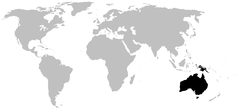Myobatrachidae
| Myobatrachidae | |
|---|---|

| |
| The common eastern froglet (Crinia signifera) | |
| Scientific classification | |
| Kingdom: | |
| Phylum: | |
| Class: | |
| Order: | |
| Suborder: | |
| Family: | Myobatrachidae Schlegel, 1850
|
| Subfamilies | |
| |

| |
| Distribution of Myobatrachidae (in black) | |
The Myobatrachidae (commonly known as the Australian ground frogs) are a family of frogs found in Australia and New Guinea. Members of this family vary greatly in size, from species less than 1.5 cm (0.59 in) long, to the second-largest frog in Australia, the giant barred frog (Mixophyes iteratus), at 12 cm (4.7 in) in length. The entire family is either terrestrial or aquatic frogs, with no arboreal species.
Characteristics
The Myobatrachidae family contains forms of parental care unique in the animal kingdom. The two species of gastric-brooding frog (genus: Rheobatrachus), are found in this family. The females of these species swallow their young, where they develop until metamorphosis. The pouched frog (Assa darlingtoni) has pouches on the sides of its body. The male will guard the eggs until hatching, and assist the tadpoles into its side, where they stay until metamorphosis.[1] Another form of parental care, although not unique, is found in many species of the genus Limnodynastes, where the male buries himself near an egg mass, and protects the eggs.
While many species are adapted to burrowing, helping them survive in semiarid or seasonally arid environments, the turtle frog and sandhill frog go so far as to lay their eggs directly into moist sand several feet below the surface, rather than into water. These species lack tadpoles, with the eggs hatching directly into miniature frogs.[1]
These frogs lack adhesive toe discs found in the tree frogs. The family is broken into subfamilies based mainly upon their egg-laying habits. Those of the subfamily Limnodynastinae lay foam nests. The female creates foam by agitating a chemical on her skin with her hands. The foam may float on top of water, or be on land. The subfamily Rheobatrachinae contains the two species of gastric-brooding frogs, and the rest are within the subfamily Myobatrachinae.
Taxonomy
The myobatrachids are split into three subfamilies: Myobatrachinae, Limnodynastinae, and Rheobatrachinae. Although most sources class the three groups as subfamilies, some taxonomists recognise them as individual families.
| Subfamilia | Species | Common name | Binomial name |
|---|---|---|---|
| Limnodynastinae[2] | 1 | Tusked frog | Adelotus Ogilby, 1907 |
| 6 | Giant burrowing frogs | Heleioporus Gray, 1841 | |
| 4 | Cannibal frogs | Lechriodus Boulenger, 1882 | |
| 11 | Australian swamp frogs | Limnodynastes Fitzinger, 1843 | |
| 10 | Stubby frogs | Neobatrachus Peters, 1863 | |
| 4 | Australian spadefoot toads | Notaden Günther, 1873 | |
| 2 | Burrowing frogs | Opisthodon Steindachner, 1867 | |
| 6 | Baw Baw frogs | Philoria Spencer, 1901 | |
| Myobatrachinae[3] | 1 | Australian dumpy frogs | Arenophryne Tyler, 1976 |
| 1 | Pouched frogs | Assa Tyler, 1972 | |
| 15 | Australian froglets | Crinia Tschudi, 1838 | |
| 7 | Ground froglets | Geocrinia Blake, 1973 | |
| 1 | Nicholls' toadlets | Metacrinia Parker, 1940 | |
| 8 | Barred frogs | Mixophyes Günther, 1864 | |
| 1 | Turtle frogs | Myobatrachus Schlegel In Gray, 1850 | |
| 1 | Haswell's frogs | Paracrinia Heyer & Liem, 1976 | |
| 13 | Crowned toadlet | Pseudophryne Fitzinger, 1843 | |
| 1 | Sunset frog | Spicospina Roberts et al., 1997 | |
| 6 | Australian torrent frogs | Taudactylus Straughan & Lee, 1966 | |
| 25 | Australian toadlets | Uperoleia Gray, 1841 | |
| Rheobatrachinae[4] | 2 | Gastric-brooding frogs | Rheobatrachus Liem, 1973 |
Notes
- ^ a b c Zweifel, Richard G. (1998). Cogger, H.G. & Zweifel, R.G. (ed.). Encyclopedia of Reptiles and Amphibians. San Diego: Academic Press. pp. 90–91. ISBN 0-12-178560-2.
{{cite book}}: CS1 maint: multiple names: editors list (link) - ^ Considered a family - Limnodynastidae by some authors.
- ^ Considered a family - Myobatrachidae by some authors.
- ^ Combined with the Myobatrachidae by some authors.
References
- Cogger, H.G.; R.G. Zweifel; D. Kirschner (2004). Encyclopedia of Reptiles & Amphibians Second Edition. Fog City Press. ISBN 1-877019-69-0.
